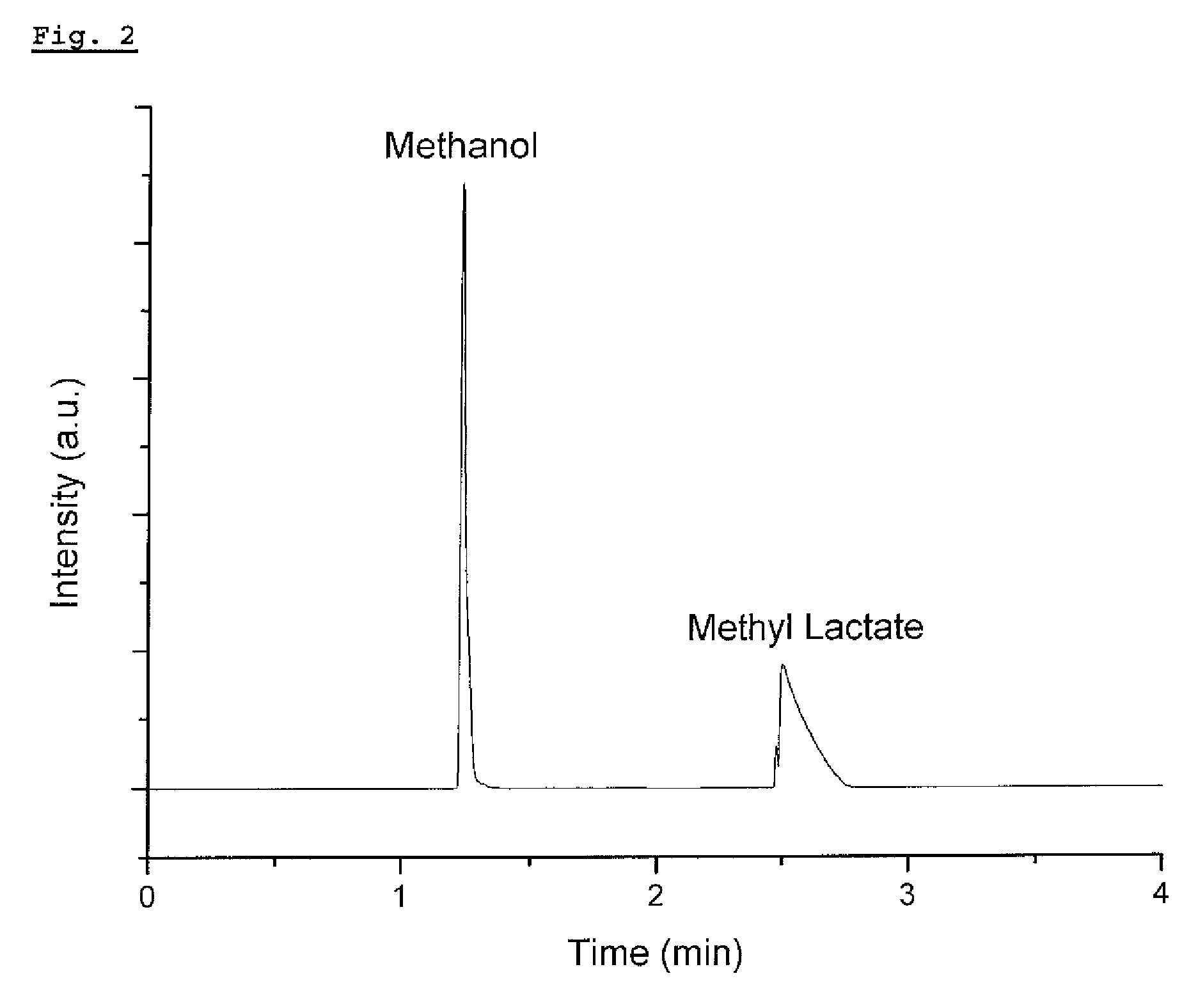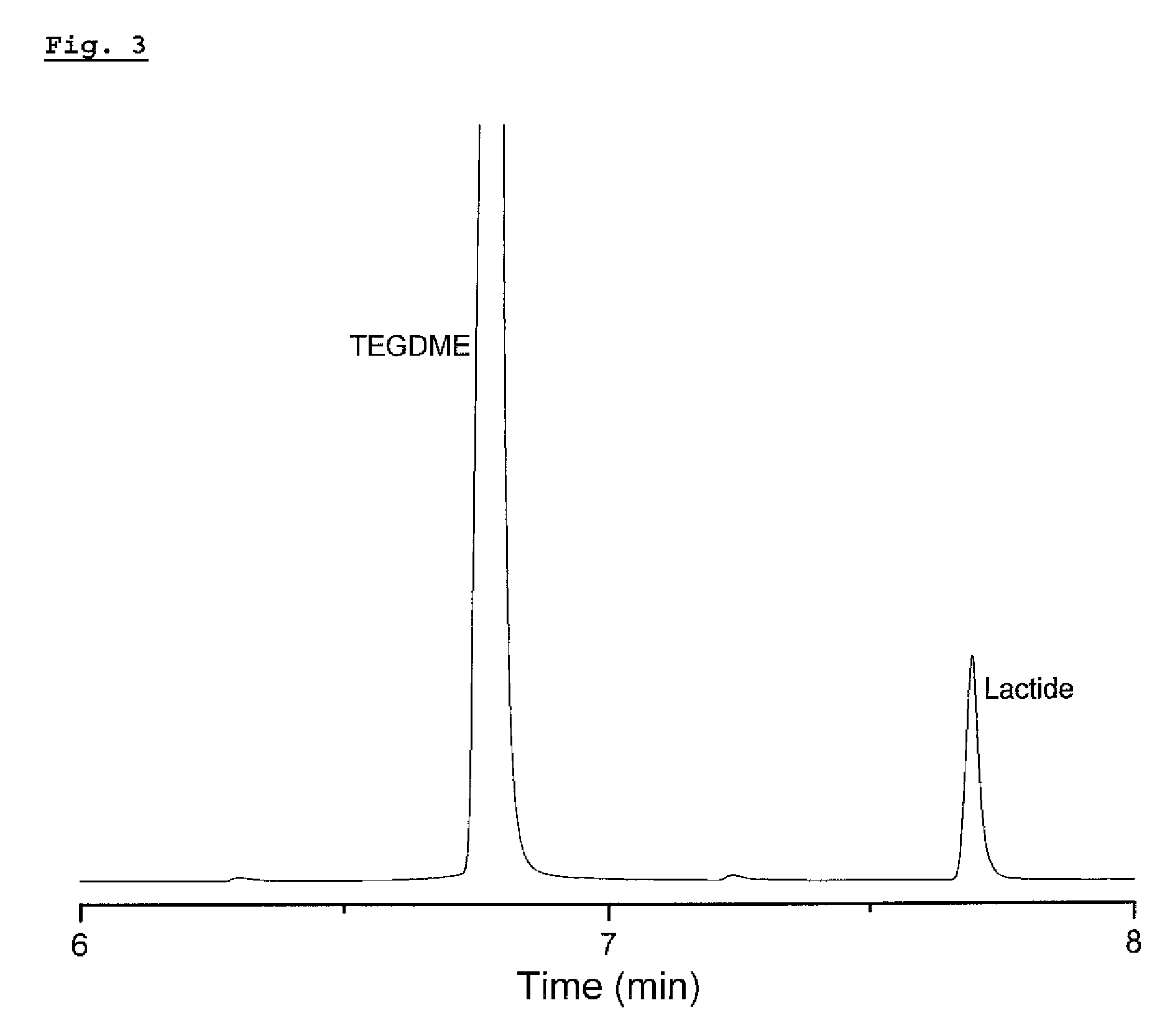Recovery method of highly pure lactic acid and alkyl lactate
a recovery method and high-purity technology, applied in the field of recovery methods of high-purity alkyl lactate and lactic acid, can solve the problems of slow reaction rate, high investment cost of equipment for dissociation at high pressure and membrane, and complicated recovery process of lactic acid into lactic acid, etc., and achieve the effect of recovering high-purity lactic acid more economically
- Summary
- Abstract
- Description
- Claims
- Application Information
AI Technical Summary
Benefits of technology
Problems solved by technology
Method used
Image
Examples
example 1
Production of Methyl Lactate and Lactic Acid
[0080]Step 1: The fermentation was carried out by using medium containing 20 weight % glucose, 0.5 weight % yeast extract, 0.05 weight % K2HPO5, 0.05 weight % KH2PO4, 0.1 weight % sodium acetate, 0.02 weight % MgSO47H2O and 30 ppm MnSO47H2O and Lactobacillus paracasei under an anaerobic condition at 35° C. The pH of the fermentation liquid was adjusted to pH 5.5 using 25 weight % of ammonia solution. Two days after fermentation, the powdered pellet was removed by centrifugation. Particles and bacteria were removed by ultra filtration to produce a lactic acid fermentation liquid with the purity of 96% L-type optical isomer and 4% D-type optical isomer. The final concentration of lactic acid in the lactic acid fermentation liquid was 16.8 g / L.
[0081]Step 2: Seventy five grams of water was dehydrated from 100 g of lactic acid fermentation liquid using rotary evaporator for 2 hrs at 50° C.
[0082]Step 3: 25 g of methanol and 12 g of 98% sulfuric ...
example 2
Production of Ethyl Lactate and Lactic Acid
[0087]Step 1: The fermentation was carried out by using medium containing 20 weight % glucose, 0.5 weight % yeast extract, 0.05 weight % K2HPO5, 0.05 weight % KH2PO4, 0.1 weight % sodium acetate, 0.02 weight % MgSO47H2O and 30 ppm MnSO47H2O and Lactobacillus paracasei under an anaerobic condition at 35° C. The pH of the fermentation liquid was adjusted to pH 5.5 using 25 weight % of ammonia solution. Two days after fermentation, the powdered pellet was removed by centrifugation. Particles and bacteria were removed by ultra filtration to produce lactic acid fermentation liquid with the purity of 96% L-type optical isomer and 4% D-type optical isomer. The final concentration of lactic acid in the lactic acid fermentation liquid was 16.8 g / L.
[0088]Step 2: Seventy five grams of water was dehydrated from 100 g of lactic acid fermentation liquid by using rotary evaporator for 2 hrs at 50° C.
[0089]Step 3: 35 g of ethanol and 12 g of 98% sulfuric a...
example 3
Production of N-Propyl Lactate and Lactic Acid
[0094]Step 1: The fermentation was carried out by using medium containing 20 weight % glucose, 0.5 weight % yeast extract, 0.05 weight % K2HPO5, 0.05 weight % KH2PO4, 0.1 weight % sodium acetate, 0.02 weight % MgSO47H2O and 30 ppm MnSO47H2O and Lactobacillus paracasei under an anaerobic condition at 35° C. The pH of the fermentation liquid was adjusted to pH 5.5 using 25 weight % of ammonia solution. Two days after fermentation, the powdered pellet was removed by centrifugation. Particles and bacteria were removed by ultra filtration to produce lactic acid fermentation liquid with the purity of 96% L-type optical isomer and 4% D-type optical isomer. The final concentration of lactic acid in the lactic acid fermentation liquid was 16.8 g / L.
[0095]Step 2: Seventy five grams of water was dehydrated from 100 g of lactic acid fermentation liquid by using rotary evaporator for 2 hrs at 50° C.
[0096]Step 3: 50 g of n-propanol and 12 g of 98% sulf...
PUM
| Property | Measurement | Unit |
|---|---|---|
| weight % | aaaaa | aaaaa |
| temperatures | aaaaa | aaaaa |
| temperatures | aaaaa | aaaaa |
Abstract
Description
Claims
Application Information
 Login to View More
Login to View More - R&D
- Intellectual Property
- Life Sciences
- Materials
- Tech Scout
- Unparalleled Data Quality
- Higher Quality Content
- 60% Fewer Hallucinations
Browse by: Latest US Patents, China's latest patents, Technical Efficacy Thesaurus, Application Domain, Technology Topic, Popular Technical Reports.
© 2025 PatSnap. All rights reserved.Legal|Privacy policy|Modern Slavery Act Transparency Statement|Sitemap|About US| Contact US: help@patsnap.com



